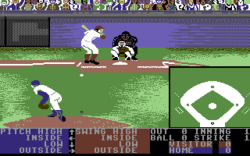HardBall!
| HardBall! | |
|---|---|
 Apple IIGS cover art for HardBall! | |
| Publisher(s) | Accolade |
| Designer(s) | Bob Whitehead |
| Artist(s) | Mimi Doggett |
| Composer(s) | Ed Bogas |
| Series | HardBall |
| Platform(s) | Amiga, Amstrad CPC, Apple II, Apple IIGS, Atari 8-bit family, Atari ST, Commodore 64, DOS, Macintosh, MSX, Sega Genesis, ZX Spectrum |
| Release date(s) |
|
| Genre(s) | Traditional baseball simulation |
| Mode(s) | Single-player, multiplayer |

HardBall! is the first in a series of popular baseball computer and video games published by Accolade. It was released for a variety of platforms between 1985 and 1991.
Gameplay
Play is controlled with a joystick or arrow keys and an action button. One of the four cardinal directions is used to choose the pitch, and again to aim it towards low, high, inside (towards batter), or outside (away from batter). The same directions are used to aim the swing when batting. When fielding after a hit, the defensive player closest to the ball will flash to show it is the one currently under control. The four directions are then used to throw to one of the four bases.
Hardball! was one of the first baseball video games to incorporate the perspective from the pitcher's mound, similar to MLB broadcasts. There are also managerial options available. The player has a selection of pitchers to choose from. Each team member has his own statistics that affect his performance, and can be rearranged as desired. Prior to HardBall!s release, there were managerial baseball games available, such as Micro League Baseball but HardBall! was the first to integrate that aspect with the arcade control of the game action itself.
In later releases in the series, announcer Al Michaels would provide commentary.
HardBall 5 is notable for its unique features, some of which have since become standard in modern baseball video games:
- Complete roster modifications, including sending players to the minors, free agency, and trading.
- Play-by-play by Al Michaels
- A complete league of "historic teams", divided into "Legends" and "Immortals". This league acts as a substitute for MLB and can have a regular season, playoffs, and World Series. There is even an All Star Game between the Legends and Immortals.
HardBall 5, while having every team and player as of that season, does not feature team names or logos. Fictional logos are used in place of the regular team logos (e.g. the Atlanta Braves logo has been replaced with a logo depicting a raptor head in front of a baseball).
Reception
Hardball! was Accolade's best-selling Commodore game as of late 1987.[1] A.N.A.L.O.G. praised the Atari version's gameplay, graphic, and animation, only criticizing the computer opponent's low difficulty level. The magazine concluded that the game "is in a league of its own, above all other Atari sports games—simulations included".[2] In an overview of statistics-oriented baseball games, Computer Gaming World stated that Hardball "would probably be disappointing to anyone other than an avid arcade fan".[3] Compute!'s Apple Applications stated that the Apple II and Macintosh versions had "almost everything you could want from a baseball simulation", with good support for playing as manager, player, or statistician and "exceptionally clear and precise graphics". The magazine concluded that "Hardball's realism is outstanding—at a level unmatched by other baseball software to date".[4] The game was reviewed in 1988 in Dragon #132 by Hartley, Patricia, and Kirk Lesser in "The Role of Computers" column. The reviewers gave the game 5 out of 5 stars.[5]
In other media
The game appears in the opening scene of the 1987 film The Princess Bride, being played by Fred Savage.
See also
References
- ↑ Ferrell, Keith (December 1987). "The Commodore Games That Live On And On". Compute's Gazette. pp. 18–22. Retrieved 24 January 2015.
- ↑ Millard, Robert (December 1986). "HardBall!". A.N.A.L.O.G. p. 26. Retrieved 7 July 2014.
- ↑ Wilson, Johnny (April 1987). "Bezbol Been Berry, Berry Good To Me!" (PDF). Computer Gaming World. No. 36. pp. 42–43. Retrieved 23 April 2016.
- ↑ Florance, David (December 1987). "Hardball". Compute!'s Apple Applications. p. 106. Retrieved 18 August 2014.
- ↑ Lesser, Hartley; Lesser, Patricia; Lesser, Kirk (April 1988). "The Role of Computers". Dragon (132): 80–85.
External links
- HardBall! at World of Spectrum
- HardBall series at MobyGames
- Download HardBall 5 Demo Blast Magazine